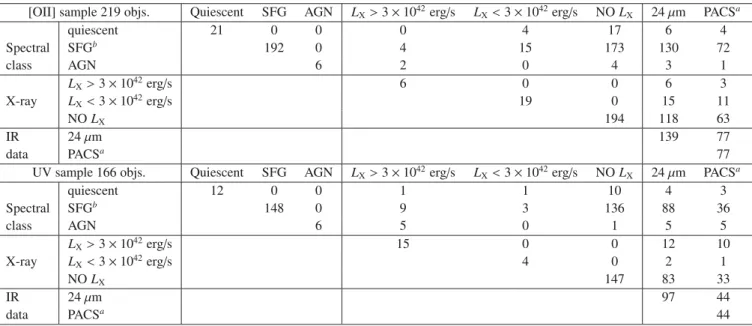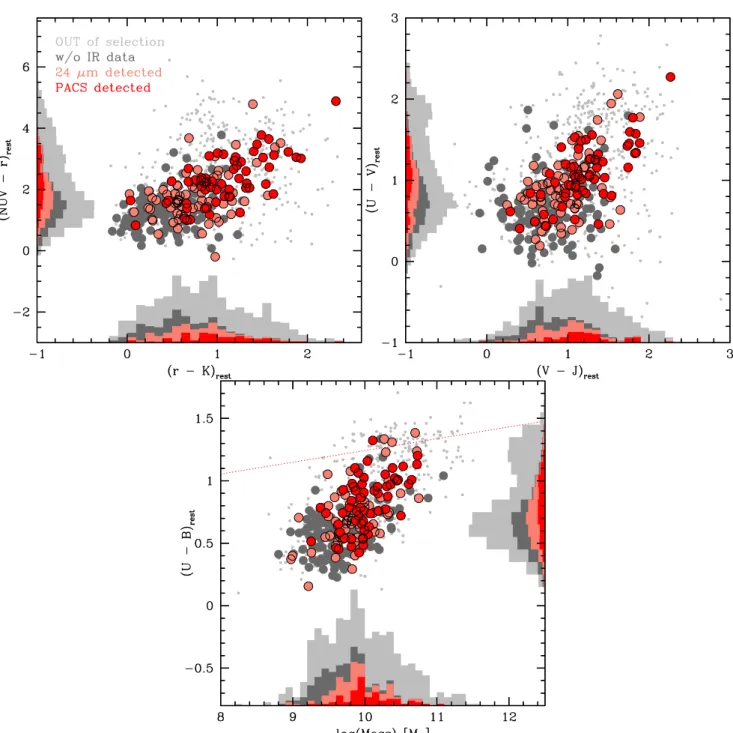The star formation rate cookbook at 1 < z < 3: Extinction-corrected relations for UV and [OII]λ3727 luminosities
Texte intégral
Figure

![Fig. 2. From top to bottom: a) average spectrum of 33 quiescent galaxies in the GMASS sample; b) average spectrum of mixed galaxies in the [OII] sample, at 1 < z < 1.6; c) average spectrum of not-mixed SFGs in the [OII] sample, at 1 < z < 1.6](https://thumb-eu.123doks.com/thumbv2/123doknet/13130439.388018/5.892.94.803.98.662/average-spectrum-quiescent-galaxies-average-spectrum-galaxies-spectrum.webp)
![Fig. 4. Continuum indices distribution over the [OII] sample: MgUV, C(29 − 33), D4000](https://thumb-eu.123doks.com/thumbv2/123doknet/13130439.388018/6.892.78.562.105.480/fig-continuum-indices-distribution-over-oii-sample-mguv.webp)

Documents relatifs
But a correct quantitative interpretation requires knowledge of the absolute line intensities of NO in the spectral range considered, in order to determine the
We investigate the effect of different star formation histories (SFHs) on the relation between stellar mass (M ∗ ) and star formation rate (SFR) using a sample of galaxies with
This method for breaking the R 23 degeneracy for ∼10 10 M galaxies cannot be derived or improved using the larger SDSS local sample of galaxies because virtually no galaxy in the
We use a spectroscopic sample of 2435 star-forming galaxies with highly reliable spectroscopic redshifts (flags 3 and 4) from the VUDS survey to study the evolution with redshift of
[r]
Module 1 page 7 www.partagesdemaitresses.wordpress.com avec la mise en page de http://maisquefaitlamaitresse.com/rseeg -ce1/ Page 8 1 En utilisant des mots dans
Agir autrement en mathématique pour la réussite des élèves en milieu défavorisé.
We observed that stereotypical CTCF DNase accessibility profiles containing a center footprint underlying the motif and flanking regions of increased hypersensitivity are
![Fig. 5. Top: average spectrum of SFGs in the UV sample, at 1.6 < z < 3; bottom: average spectrum of SFGs in the [OII] sample, at 1 < z < 1.6.](https://thumb-eu.123doks.com/thumbv2/123doknet/13130439.388018/8.892.121.777.99.764/average-spectrum-sfgs-sample-average-spectrum-sfgs-sample.webp)




![Fig. 13. A IRX vs. β phot for IR-detected galaxies in the [OII] sample. The blue line is a fit to the data (Eq](https://thumb-eu.123doks.com/thumbv2/123doknet/13130439.388018/13.892.68.432.107.473/fig-irx-phot-detected-galaxies-oii-sample-blue.webp)